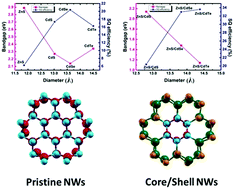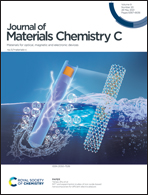ZnS/CdX (X = S, Se, Te) core/shell nanowires: an attempt at tuning the electronic bandgaps and SQ efficiencies†
Abstract
DFT-based simulations were executed to investigate the electronic structures and optical constants of ZnS, CdS, CdSe and CdTe nanowires (NWs). It was observed that all these pristine NWs had wide direct bandgaps and would find applications only in the synthesis of semiconductor lasers and LEDs. These NWs were further incorporated into ZnS/CdX (X = S, Se, Te) core/shell (c/s) configurations and it was observed that the ZnS/CdS c/s NW still had a wide bandgap that was of the direct type. However, in the cases of the ZnS/CdSe and ZnS/CdTe c/s NWs, the bandgaps were dramatically narrowed and were of the indirect type. The indirect bandgaps of the ZnS/CdSe and ZnS/CdTe c/s NWs were found to be near to the indirect bandgap of silicon and, therefore, were found to be potential alternatives for devising next-generation terrestrial micro- and nano-photovoltaic devices. The partial density of states (PDOS) and total density of states (TDOS) for all pristine and c/s NWs were also studied. It was observed that the Shockley-Quessier (SQ) efficiencies of c/s NWs were dramatically greater than the efficiencies of pristine NWs, owing to the truncated bandgaps. The ZnS/CdSe and ZnS/CdTe c/s NWs showed SQ efficiencies of 32.97% and 33.59%, respectively. In comparison, the CdSe NW had an efficiency of 20.38%, which is the highest for the pristine NWs included in the study, while the ZnS NW showed a meagre 6.24% efficiency. Subsequently, the optical properties, within the random phase approximation (RPA) of pristine and c/s NWs were investigated and compared.



 Please wait while we load your content...
Please wait while we load your content...